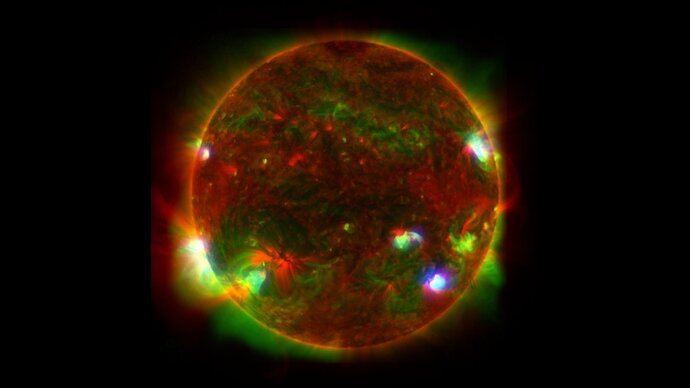Student-planned NuSTAR observation reveals hidden light shows on the Sun

UMN physics grad students Marianne Peterson and Reed Masek, as well as recent physics Ph.D. recipient Jessie Duncan, under the guidance of Associate Professor Lindsay Glesener, of the School of Physics and Astronomy, all worked on a successful proposal to NASA to use the NuSTAR (Nuclear Spectroscopic Telescope Array)--typically used to view bodies outside the solar system such as massive black holes and collapsed stars-- to observe the Sun. The group is also actively analyzing the data obtained from the observations.
A new image from one of the observation runs displays invisible to the human eye, including the high-energy X-rays observed by NASA’s NuSTAR observatory, emitted by some of the hottest material on the Sun’s surface. This image as well as others from previous solar observations are already providing astronomers with insights about our Sun.
The high-energy emission may hold the answer to one of the biggest mysteries about our nearest star: Why the Sun’s outer atmosphere, called the corona, maintains a temperature of millions of degrees – over 100 times hotter than its surface. Why this has puzzled scientists is because the Sun’s heat originates in its core and travels outward. It’s as if the air around a fire were over 100 times hotter than the flames.
The source of the corona’s heat could be small eruptions on the Sun’s surface called nanoflares. Flares are large outbursts of heat, light, and particles, and are visible to a wide range of solar observatories. Much smaller events called nanoflares also produce material hotter than the average temperature on the surface, and it’s possible there are enough of these tiny events happening that they collectively heat the corona to higher temperatures.
Although nanoflares are so small that they are almost invisible amid the Sun’s blazing light, NuSTAR is sensitive enough to spot their signatures, which enables physicists to study their frequency and investigate how much energy they release..
The observations used in the image coincided with the 12th close approach to the Sun, or perihelion, by NASA’s Parker Solar Probe, which is flying closer to the Sun than any other spacecraft in history. Taking observations with NuSTAR during Parker’s perihelion will enable scientists to link activity in different parts of the Sun’s atmosphere to activity in interplanetary space, and thus understand the details of how dynamic solar activity affects the rest of the solar system.